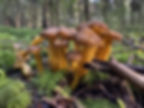Winter chanterelle - Craterellus tubaeformis
- The Foraging Course Company
- Jun 11
- 2 min read

Edible mushroom - novice Season - autumn to winter Common names Winter chanterelle, trumpet chanterelle, Chanterelle, yellow legs, yellow foot, funnel chanterelle, yellow foot trumpet
Scientific name meaning: Craterellus comes from the Greek krater, meaning cup. Tubaeformis is from the Latin tuba, meaning trumpet, and forma, meaning the appearance of
Overall structure and growth  A cap and stem mushroom that often appears in extremely large, tightly-packed groups. However, its brown, wavy cap makes it difficult to spot in leaft litter. |
Cap  The thin brown cap has a wavy edge and is slightly paler at the margin. It reaches 2 to 5cm in diameter and greys with age. It is funnel shaped and often has a hole in its centre. |
Veins and spores  The veins, or false gills, are yellow when young and become more pale and grey with age. They are decurrent, wrinkled, forked and have cross veins, too. They are formed from folds of the spore producing surface. The spores are white to pale yellow. |
Stem  The yellow stem is 2 to 8cm tall and 0.5 to 1cm wide. It is hollow and usually grooved, giving the appearance of having a pair of legs. It is often swollen at the base. There is no stem ring/skirt. |
Flesh, taste and smell  The flesh is pale yellow to white and does not change colour. The smell and taste are mild. |
Possible lookalikes  The jelly baby (Leotia lubrica) could be confused for a young winter chanterelle. However, jelly baby mushrooms have a smooth surface under their wrinkled cap, rather than veins. Jelly babies are considered inedible, despite their name. |
Use as food Edible when cooked. Can be dehydrated and used later. Excellent flavour for savoury dishes. Can also be pickled or caramelised for sweet dishes Hazards Thought to be an effective bioaccumulator of heavy metals so harvesting from contaminated areas should be avoided
Use in herbal medicine and medicine None known
If you are suffering from any ailment or need medical advice, please see your General Practitioner Other uses None known Importance to other species Provides food for a the larvae of a number of invertebrates
Always stay safe when foraging. You need to be 100% sure of your identification, 100% sure that your foraged item is edible, and 100% sure that you are not allergic to it (it is good practice to always try a small amount of any new food you are consuming). If in doubt, leave it out!






